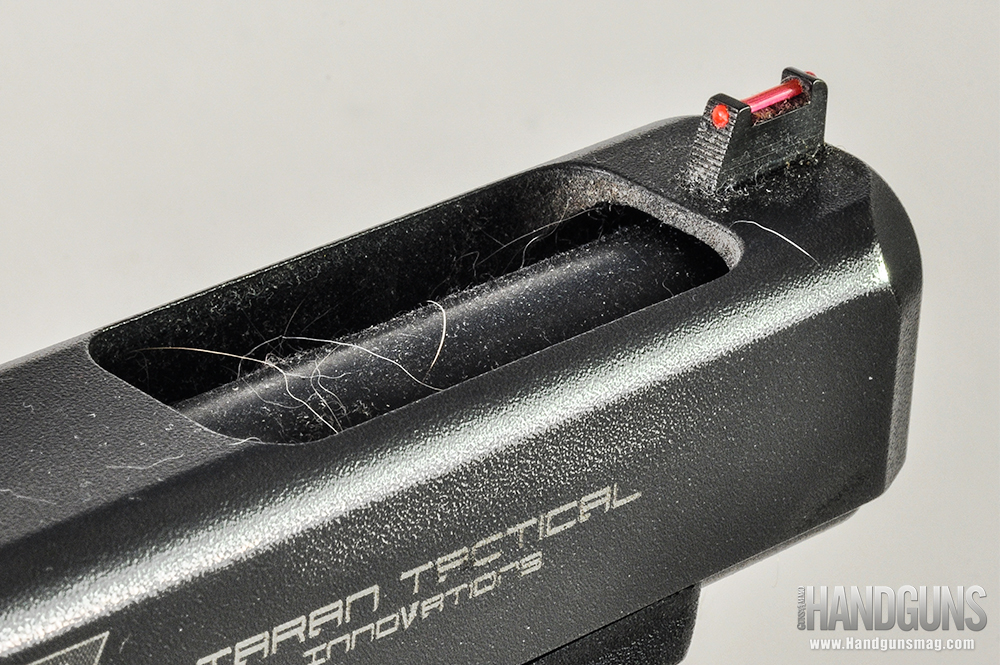
You’ve got your CCW, a reliable pistol that you’ve practiced with and premium defensive ammo. All you need to do is load up, holster (or pocket) your equalizer, and you should be good, right?
Well, yes, but not forever. Whether you take your gun off (holster and all) every night, rarely carry concealed or practice regularly with your daily carry gun, at some point, you will have to deal with some maintenance issues.
1. Lint
I’m using ‘lint’ as a catchall term for everything that isn’t firearm
residue that works its way into every nook and cranny of your handgun if
given enough time. This could be dust, lint, dirt, etc. You know how
dusty a table gets just sitting out in the middle of a room? Now imagine
that that table was in your pocket. Do you own a dog or a cat? Just
assume their hair will end up on and in your gun.
How much lint you’ll have to deal with is a product of many factors, including type of gun and method of carry. A snubbie stuck into the pocket of a new pair of cotton sweatpants will be as fuzzy as a teddy bear at the end of the day. A Glock in a kydex outside-the-waistband (OWB) holster obviously won’t have as much lint.
I typically carry in an OWB holster, and merely changing the type of covering garment I’m using can drastically change the amount of lint which collects. Rayon Hawaiian shirt? No lint. How about a brand new 100-percent cotton sweatshirt? I’ve been there and done that, and there was so much fuzz between the cocked hammer of my 1911 and the frame that I seriously wondered if the hammer would hit the firing pin with enough force to fire the gun.
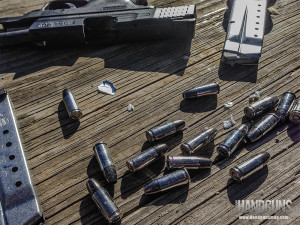
Unless you seal it up tight in a plastic bag, your carry gun will get covered with varying amounts of dust, lint or animal hair. Blow it or wipe down the exterior frequently, and strip it from time to time to wipe out the lint that gets everywhere.
Gun type also matters. A 1911, with its hammer and external controls, has many more edges that can scrape lint off your clothing than, say, a Glock. A revolver has all sorts of gaps between cylinder and frame, but will a lot of lint in there affect reliability? Probably not. Also, dry, clean guns collect less lint than dirty or well-lubed handguns.
Think your gun won’t get linty or dusty because it’s tightly wrapped in a form-fitting holster? Think again. Whether you carry every day or once a month, I recommend examining your gun at the end of every day or two of carry. Blow or wipe off the external lint, and then, every week or so of carry, fieldstrip the gun. You’ll see that lint has gotten everywhere. Because it’s not “dirty,” you won’t need to clean it. Just wipe it down, put it back together, load it back up, and you’ll be good to go.
2. Lube
There isn’t a handgun on the planet that doesn’t run better when it’s well lubed. While they run just fine dry, even Glocks cycle much more smoothly when properly lubricated. But keeping your carry piece lubed up can be surprisingly problematic.
First, let’s state the obvious, which is related to our first point: Lint has a much harder time adhering to dry metal. Lubing your gun will cause dust and lint to stick to all of its cracks and crevices. There’s no way to prevent this, so just be aware of it.
Anyone who has ever carried a well-lubed handgun for any length of time will have also learned that lube just doesn’t stay where you put it. Whether it evaporates, drips out, gets rubbed off on clothing, soaked up by lint, whatever, the end result is that in just a few short days of carry, a well-lubed gun can become anything but.
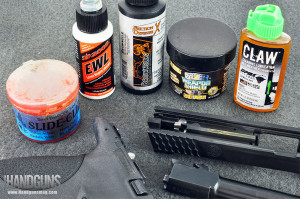
Whether it drips off, evaporates or gets removed through handling, carry guns lose their lube faster than you might think. Thicker lubes and greases tend to stay where they’re put longer, but they don’t work as well in very tight guns.
Because of this “migrating” lube issue, I have switched from using light oils in my carry Glock to heavier pastes, so the lube stays where I put it for much longer. Currently, I trade off between WeaponShield’s Lithium Grease and Brian Enos’ Slide Glide, both of which are more gel than fluid. However, to some extent, the type of lube you can use depends on your firearm.
If you’re carrying a Glock with the usual loose rattly fit, slathering thick lube on the rails won’t change anything. If, on the other hand, you’re carrying a very tightly fit 1911, thick lube might gum up the works. When I carry my SIG P226, I have to stay away from the greases and just use light oil on the barrel and frame rails … and reapply every few days as necessary (after lint removal, of course).
3. Wear
Let’s talk holster wear first. Holster wear does not affect accuracy or
reliability, but it does affect appearance. If you’re as concerned about
your handgun’s appearance as you are with its performance, you might
wonder if there is a type of carry or holster that protects the
finish/looks of a handgun more than another. Not really. Sorry.
Whether you carry a snubbie loose in your pocket or a Glock in an OWB kydex holster, every type of carry will eventually leave marks on your handgun, no matter what type or brand of pistol you’re carrying. However, I have found that different types of holsters cause different types of wear.
Kydex hardly flexes, so its wear points are constant and smaller. They are, for the most part, limited to the places where the pistol rests or is locked into place. You’ll usually see kydex/polymer holsters causing wear to the front edge of slides, for instance, or the front edges of trigger guards.
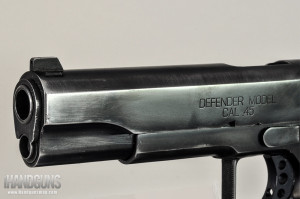
Holster wear is an inevitable outcome, and the more you carry, the quicker the wear shows. Stainless steel shows the least wear, while bluing shows the most. The bluing has been worn off every sharp edge on this Springfield Armory 1911 from years of daily carry in a horsehide holster.
Leather holsters, on the other hand, grab guns like gloves. Over time, they get impregnated with lint, dust and carbon fouling, all of which can have an abrasive effect on your firearm’s finish. If you only carry your gun once in a while, it might take you months or years to notice any wear. If you carry every day, you’ll see wear spots develop in just a few weeks. That’s life, folks.
Finish has more of a limiting effect on wear than anything else. Stainless guns really have to be brutalized before they show much of anything, and even then it’s usually just a matte finish getting polished in a few places. Even scratches don’t show as badly on stainless steel.
Plain, old-fashioned bluing is the worst. It rubs off quickly in holsters, and if you carry a blued gun in a hot climate, at some point, your gun will start to rust. This is not an “If” but rather a “When” equation. Blued guns plus daily “on-body” carry equals rust. I recommend wiping down your blued carry gun every day and giving it a fresh coat of oil. This should keep the rust at bay, but you’ll still have wear issues.
4. Ammo recycling
My girlfriend is a big proponent of recycling, but I usually just refer
to it as a “hippie conspiracy.” The one exception is when talking about
the ammo in a carry gun.
All shooters who carry should practice shooting their carry gun. Most of us aren’t financially secure enough to practice with the expensive defensive ammo we use for carry, which means loading and unloading the same cartridges over and over to make room for practice FMJ ammo. The more times a cartridge gets cycled in and out of a magazine or chamber, the greater the chance it will get damaged. I have quite often noticed that my “chamber round” gets set back in the case after banging against the feed ramp enough times. This can cause dangerous pressure issues.
The next time you take your carry gun to the range to practice, carefully inspect your carry ammo for dings, scratches and bullets set back into the case. Discard any rounds that are damaged. Yes, I know, that JHP ammo is darned expensive, but damaged ammo can easily affect the reliability of a semi-auto.
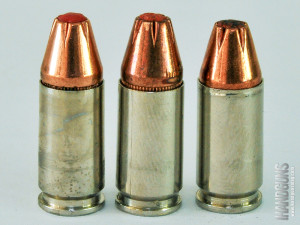
Check your ammo and renew it from time to time. Left — a fresh-out-of-the-box Hornady Critical Duty 9mm. Center is a cartridge that has been in the author’s spare magazine for about six months. It’s starting to discolor and show a little wear on the tip. At right is a round that needs to be discarded; not only is the red rubber FTX tip now black, cycling it in and out of the chamber has caused the bullet to set back into the case.
Also, how old is your carry ammo? Hopefully, you’re still not carrying around the same cartridges you stuffed into the gun when you began carrying it in 1989. Ammo, when stored in dry, cool, steady conditions can last a lifetime. Ammo in a carry gun subjected to different humidities and temperatures, not to mention body heat and sweat, has a much shorter lifespan. How long is anyone’s guess.
Personally, I carry every day, and every year or so, I shoot the ammo I’ve been carrying around in my pistol. Then I replace it with fresh stuff. This probably affects my peace of mind more than anything else, but peace of mind is why I carry a gun in the first place.


 Colt社가 파산신청
Colt社가 파산신청
